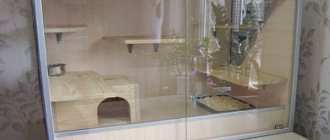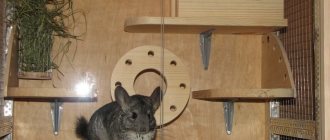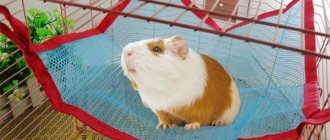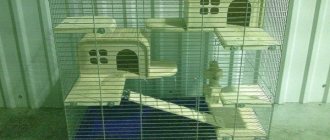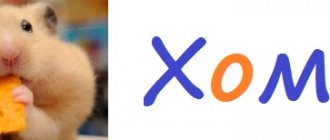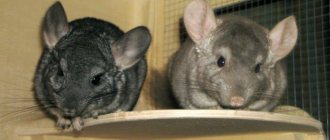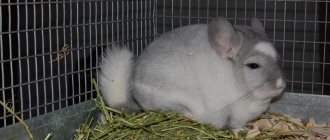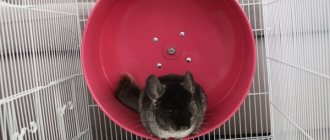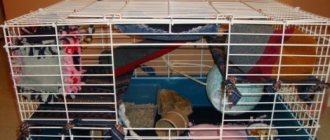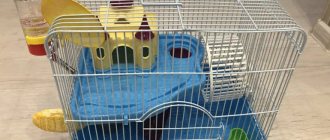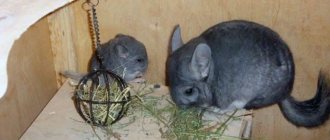Before purchasing a fluffy and very active animal, you need to arrange a place for it to live. Like all rodents, chinchillas love to taste everything. An animal running freely around the house includes chewed furniture, baseboards, walls and electrical wires. This not only outrages the owners, but also poses a danger to the chinchilla itself.
There are commercially produced cages for chinchillas, but not all pet stores can buy them. In addition, a purchased cage provides only the minimum needs of the animal, and the owner usually wants his pet to be happy. You can make a custom cage for a chinchilla yourself.
Why a showcase?
The most suitable housing option for a rodent would be a display case. It must be completely closed, this is necessary for the animal to feel comfortable and protected. The main difference between this type of housing and a cage is the ability to use various types of materials when making it yourself.
The best material, of course, will be wood, since this material is environmentally friendly for the animal. But the material also has disadvantages: wood absorbs moisture and odors that come from the animal very well. In addition to this material, fiberboard, chipboard, and aluminum profiles are used. The aluminum profile option will be the most convenient and durable, but its cost will also be higher than other options.
Advantages of the showcase:
- The area around the animal’s house will always be clean, as no debris will spill through the bars.
- Cleaning is quick and easy.
- There is much less noise from an animal that lives in a window.
- The pet will not chew metal rods that are painted.
- By making a contraction according to your own drawings, you can make the display case an element of the room’s design.
- By screwing the wheels to the bottom of the display case, it can be easily moved from place to place.
This housing option is very convenient and this will become immediately clear as soon as the animal is moved into it.
Original ideas
Creative owners of furry pets offer interesting options for making multifunctional houses. So, one of them is a house combined with a hay barn: shelter - one, material for gnawing - two, a place for hay placed between the sticks - three. To make such a product you need a minimum of materials:
- board as a roof,
- dry birch or hazel sticks (due to the density of this type of wood, the chinchilla will chew them longer),
- a block for fastening them,
- small screws, screws or nails - for the same purpose.
When finished, the house looks like a nice and quite cozy hut for a rodent.
You can make a special “gnawing” house for your pet from branches and wooden scraps, fastening them with the same connecting parts.
Below are the drawings of the houses - several options.
Homemade houses are also an economical option. If you build an entire cage or display case for a chinchilla with your own hands, its total price will be several times lower than the store price. So, dear craftsmen, get a jigsaw in your hands!
Step-by-step manufacturing instructions
Showcase drawing To make a display case for a chinchilla yourself, you first need to draw up a drawing.
An interesting suitable option can be found on the Internet - when using, substitute your dimensions to see if you can make the model you like. If you do not have sufficient experience in construction work, it is better to take a simpler drawing, as in this photo: After all the measurements have been taken and transferred to the diagram, all drawings are made on paper on a reduced scale. At this stage it is important to carefully check that all dimensions are correct.
Then, using a ruler, marker or chalk, the details of the drawing are transferred to life-size pieces of wood or chipboard. Next, the following steps are performed:
- The parts of the rack are cut out from the prepared materials using a hacksaw or electric jigsaw exactly in accordance with the diagram. For metal, a grinder and appropriate cutting wheels are used. If home conditions do not allow you to work with parts, or there are no suitable tools, you can contact a workshop. Such a service will not be free, but still will not require large expenses.
- Windows are cut out in the side walls for ventilation and covered with mesh. Pieces of mesh are cut using metal scissors and then attached with wide-headed screws. To disguise and protect the mounting points, you can use metal profile thresholds.
Windows for ventilation are covered with mesh - Ventilation holes are also often made in the ceiling - you can cover it entirely with a mesh. It will be convenient to attach fastenings for hanging toys and hammocks to the metal mesh cells.
- In the marked places, drill holes for the tie screws. Their task will be to fasten the parts together.
- First, the rear and side walls are attached to the pallet, then the ceiling is installed using the same principle.
- Install fastenings for shelves and the shelves themselves.
- Screw the door hinges holding the glass facade.
- In places where chipboard cuts are visible, glue PVC tape.
- To protect pets from drafts, the display case must be raised to a height of 30-50cm. For this purpose, you can cut out wooden legs, but it is better to make a bedside table. Then this space under the shelving can be used to store food, sand, bathing suits, toys and other accessories for keeping animals.
- In order to assemble the bedside table, screws and self-tapping screws are used, the hinged door is attached to furniture hinges , and special magnetic fittings can be used as a lock.
Cage from an old closet
The simplest and most economical option. If you have an old cabinet with glass doors at home, it can easily be converted into a spacious cage. To do this, several windows are cut out on the sides for ventilation, which are covered with mesh. You can also make a window on the roof. The internal space is divided into shelves, in which convenient openings are made and ladders are installed. A special lock must be attached to the glass door. Several drinking bowls, a feeding trough are installed inside, and a manger for hay is hung separately. The upper level is most often equipped with a house and hammocks, and in the middle there are toys and tunnels.
Popular cell types
Sand for its composition, special attention is paid to it, since the beauty of the fur skin depends on it. The animals perform hygienic procedures in sand, while the use of river sand, as well as quartz sand, is excluded. With sharp fragments, the material does not clean the fur, but spoils and cuts the hair.
Breeders began to use a composition made from volcanic dust. It provides excellent cleaning with good moisture absorption. It is believed that the animals behaved this way in their natural environment, and bathed in this substance.
You can check the quality of dust content in the package only after opening it; the color of the composition should be matte; any shine indicates foreign particles. If you rub them in your hands, there should be a trace left on them, like powder, when poured with liquid, the real dust will dissolve, and the heavy quartz will settle to the bottom of the container. Before arranging a swim, you need to resolve the issue of housing. Home cages are somewhat different from professional cages.
The following designs were included in the review, the most popular among breeders:
- Houses connected with metal rods. Similar options are presented by sales representatives; they are easy to build yourself. The advantage of such buildings is their low cost and ease of installation.
- Manufacturers, in general, completely supply all the necessary parts; it will not be difficult for the owner to assemble the elements and not worry about further arrangement.
- Dwellings presented as a kind of showcase will be needed by those who decide to start a family of chinchillas. In this constructive space there are all the details necessary for future offspring. The material chosen is different, but suitable both for interior decoration, where wood is preferred, and for external structures made of metal elements.
A thrifty owner is not prohibited from starting construction on his own, using improvised products that have fallen out of use among household members. The best solution would be to first display the building plan on paper. The drawing will allow you to calculate all the necessary parts by size and quantity. A display-type dwelling can be built from old furniture; cabinets and chests of drawers are suitable for various configurations.
Chinchillas have become a profitable business because of their fur. For commercial breeding, cages of other sizes and designs are needed, designed for the constant reproduction of individuals.
Breeders take into account the number of females required for one male for effective productivity.
A male can serve up to 8 chinchillas, but the owner tries to keep a good sire and prefers to give him no more than 4 future mothers. The cells are arranged in cells arranged on floors, where each is intended for one family. The uteri are separated from each other by their own space, but the rodent moves freely between them through a special passage built into each combined cell wall.
Prevention and care of display cases
Cosmetic cleaning including washing the toilet, drinking bowl, and feeder must be done daily. If there is no tray, the litter should also be changed daily. If the chinchilla is litter box trained, the bedding is changed once a month.
Video: how to clean a chinchilla's window display
General cleaning is done once a week. In order to do it, the chinchilla needs to be removed from the enclosure and placed in a carrier. Then remove all loose objects: house, tunnels, etc.
Did you know? To scare the enemy, the chinchilla stands on its hind legs and shoots a stream of urine at it. And if a predator grabs her, she can shed scraps of fur in order to escape.
After this, you can start cleaning up the debris using a vacuum cleaner. Then wash the bottom of the display case with a weak soda solution and a sponge, and wipe the floor dry.
Side walls and doors should be wiped with a damp cloth and also wiped dry. All items that were in the middle of the display case should be thoroughly washed, dried and placed in their places.
If you need to disinfect the room, you will need to use special products purchased at a pet store.
Surely most chinchilla owners purchased it in order to be touched by this fluffy creature. Therefore, each of the breeders is simply obliged to repay the pet with a good attitude, quality care and the creation of comfortable living conditions. After all, the life expectancy of an animal directly depends on these factors. A home for a chinchilla in the form of a display case can be either purchased or made with your own hands.
To make your pet feel comfortable in it, it is important to follow the recommendations for its area and arrangement.
You will need
- — steel fine mesh;
- - metal elements - corners, tubes, loops;
- - Bulgarian;
- - welding machine.
Instructions
The most suitable cage space for one rodent is considered to be 70x50x50 cm in size. In this space it will be necessary to place various necessary accessories - a drinker and feeder, a sand bath and a hanging hammock, various toys, exercise equipment to support the animal’s motor activity.
Ready-made cells are offered on the market in a wide variety, but they are not cheap. More budget cages made in China raise many questions regarding their reliability. It is not surprising that most owners prefer to make a home for the animal themselves.
Sketch out a sketch of the future cell on paper or draw a plan. Be sure to calculate the location of the cage in human housing and the internal equipment of the house for the rodent. Consider the location of feeders and shelves, labyrinths, tunnels, slides and other elements.
Make a frame for the future cage - it should be made of metal tubes, which are fastened with corners and screws with corner nuts. You can immediately divide the space inside into several sections and outline transitions to connect them. Weld a bottom plate to the cage frame and make a flooring to get a wooden floor. Arrange and secure the walls - they can also be made of wood or metal mesh.
Consider the design of the cage's attachment to the roof posts. It should be made removable - this way you make it easier for yourself to periodically clean the cage. For example, hinges with, but not with a latch, are suitable. Prepare the interior of the cage: install and secure the shelves, also secure the ladders, houses, drinking bowls and feeders. Place a container with sand and lay hay on the bottom of the cage. The cage is ready.
note
The room where you plan to install cages with chinchillas must be well ventilated. Drafts are excluded. Preferred air humidity is up to 70%, temperature is 5-25 degrees Celsius. The cage should not be installed near a battery or in a place where it will be exposed to direct sunlight.
Helpful advice
When choosing a metal mesh, make sure that there is a distance of no more than two centimeters between its rods. Shelves should not be made of chipboard; neither a metal mesh nor a lattice will do - a chinchilla in such a cage could get hurt. The door must close securely so that the chinchilla cannot get out on its own.
The chinchilla is a cute, active animal brought from South America. Far from its homeland, the animal successfully adapted and managed to gain some popularity. It is not difficult to care for a chinchilla, you just need to understand its needs and try to please it a little.
Features of creating a design
- First of all, a do-it-yourself chinchilla display window should be at least eighty centimeters high.
- Many also leave space below for food, nutritional supplements and a variety of toys. To do this, you will need a space of at least another thirty centimeters.
- When creating a drawing of a future structure, special attention should be paid to the appearance. The house must fit completely into the existing interior.
- You also need to clearly calculate the dimensions of the cabinet that will be located under the display case. The average size is considered to be one hundred and forty centimeters, taking into account the experience of other owners of such interesting animals.
- Depth is also given a special place. It must be at least thirty centimeters. It will be convenient for the animal to run around in such a cage, and such dimensions fit quite well into the existing interior of an apartment or house.
- If we talk about width, then in this case there are no special restrictions. The only condition is that the minimum must be thirty centimeters. If the cage is narrower, the chinchilla simply will not be able to stay in it.
Town
Chinchillas are animals prone to obesity, and they need active movement just like food and water. You can make chinchillas move by building them easy-to-climb routes in the “town.”
The town includes:
- running wheel for chinchillas;
- shelves fixed at different levels;
- transitions between shelves.
The variety of transitions is limited only by the imagination and skill of the chinchilla owner.
It can be:
- suspension bridges;
- tunnels;
- stairs;
- swing.
The only requirement for all these products is natural wood without paint or varnish. You can make transitions from unsanded branches of edible tree species. And change it periodically.
The role of a transition, a toy and a place to rest is simultaneously performed by a hammock for a chinchilla suspended in a display case. It is made from dense non-stretch fabric. Denim suits well. They secure it so that the chinchilla can jump into the hammock, but cannot swing it too much.
In addition to shelves and passages, the town must have a running wheel and a treadmill. The wheels are sold in pet stores and are designed for all active small animals. You need to buy a wooden or plastic one, as a metal wheel can be dangerous for a chinchilla. But you can do it yourself.
DIY chinchilla wheel
To make a wheel you will need:
- 2 sheets of plywood with a side of at least 40 cm and a thickness of at least 1 cm;
- up to 10 figured meter slats;
- automobile tension bearing;
- drill;
- drill 12 mm;
- self-tapping screws;
- 2 bolts with a diameter of 12 mm: long and short;
- screwdriver;
- washers for bolts;
- nuts for bolts;
- jigsaw
Manufacturing technology:
- Find the middle in the pieces of plywood and drill holes. Using a jigsaw, cut out 2 circles of 30 cm in diameter.
- One is left, another circle with a diameter of 25–27 cm is cut out of the other. Only a large circle will be needed from this circle.
- The slats are cut into pieces about 15 cm long. The size of the slats depends on the chinchilla. The animal must fit freely into the wheel.
- The cut slats are attached closely to the ends of the circle and the cut out circle.
- Put a washer on the long bolt, insert the bolt from the inside into the wheel, put on another washer and screw the structure with a nut.
- A hole for a bolt is drilled in the wall of the display case.
- The center of the bearing is aligned with the hole in the wall and the bearing is screwed in with self-tapping screws.
- The wheel with the bolt is inserted into the bearing and tightened with a nut from the outside of the display case.
The video shows in sufficient detail how to make a running wheel for chinchillas.
Treadmill
For chinchillas, this is an additional device, and it is easier to buy it in a store. There it can be sold as a treadmill for decorative hedgehogs. She looks like this.
Now the display case contains everything necessary for a happy life for chinchillas. All that remains is to figure out what a walking ball is.
Chinchilla ball
This is a device that a chinchilla should not have. The plastic ball transmits infrared rays very well and heats up from the inside. Chinchillas do not tolerate heat well. Half an hour in such a ball is enough for the animal to die.
In such a ball, some careless owners of small animals let them “walk” in the fresh air and eat the green grass that falls into the cracks of the ball. Juicy food is contraindicated for chinchillas. And the stress of a walk is much more harmful than being in a spacious display case.
Requirements for the showcase
The minimum size of an enclosure for one animal should be 80x80x50 cm. If you plan to keep two pets, then, accordingly, the area should be doubled.
The display case should be made of durable and environmentally friendly materials, since the rodent will probably want to try it on its teeth.
Also among the requirements for a showcase, you should pay attention to the following:
- dryness;
- warm;
- cosiness;
- sufficient lighting;
- good ventilation.
Important! Keeping a chinchilla in cramped conditions and in violation of the above requirements will lead to the animal getting sick often.
The minimum set of items that are vital for a pet is a feeder, a drinking bowl, and a tray.
For a more comfortable pastime, you will also need a sleeping area closed from prying eyes, a hay feeder, play complexes, and other devices for relaxation and physical activity. We will talk about them in more detail in a separate section below.
Purchased and homemade cages
Pet stores offer two ready-made options for keeping chinchillas at home - a display case and a cage. Metal cages are the most common type of housing for rodents and have the following advantages:
- safety;
- Possibility to equip with additional accessories;
- ease of cleaning and disinfection;
- compactness and ease of transportation;
- durability and strength.
Chinchilla cage
However, a metal cage also has a drawback - it is too noisy, which causes inconvenience at night, when the chinchilla is in its most active period.
Another option for purchasing a cage for keeping chinchillas at home is a display case. It is spacious; usually the choice in favor of a display case is made if you want to start breeding rodents. This type of housing is a wooden frame surrounded by glass walls. Externally, the showcase resembles a spacious aquarium with several floors.
The main negative side of the display case design is the ability of the wooden frame to absorb odors and swell over time from excess moisture. Not so long ago, options for display cases with aluminum profiles appeared in pet stores, albeit at a high cost.
An alternative to purchased cages and display cases can be homemade housing for your chinchilla. The design of the future home may be different, the main thing is that the following requirements are met:
- availability of light;
- safety;
- strength;
- good ventilation.
Chinchilla cage
The cost of a homemade cage will be significantly lower than a purchased one, and you can furnish it to your liking.
How to set up a display case for a chinchilla
For the comfort of the animal, you should make sure that in the enclosure, in addition to the mandatory attributes - feeder, hay feeder (hay bowl), drinking bowl and toilet, there are items and accessories for its proper rest and wakefulness.
- Holiday house . Its purpose is to seclude the animal from prying eyes. The house should be somewhat larger than a chinchilla. She can be in it, stretched out to her full height. The house is made of wood. It can also be purchased ready-made at a pet store.
- Shelves . If your display case does not have a large area and it is impossible to install a house in it, then you should take care of arranging wooden shelves on which the pet will rest. They should be located low from the floor so that if the animal falls, it will not be injured.
- Hammock . Chinchillas love hammocks. They use them for both relaxation and entertainment. Hammocks can be of different designs, single-tiered and multi-tiered, from different materials and fabrics. They can be purchased, but most often owners make them with their own hands. However, be prepared that rodents quite often damage hammocks with their teeth.
- Toys . Like any creature, the chinchilla loves to play. Therefore, if the size of the display case allows it, you should take care of purchasing gaming complexes: tunnels, a running wheel, toys made of wood, branches, stumps.
- Sand bath . As you know, chinchillas love to bathe in sand, so you will give your pet great pleasure if you find a place in the display case for a sand bath.
Video: how to set up a display case for a chinchilla Items that should also be in the cage include a mineral or salt stone - for grinding teeth.
Also find out how to choose and arrange a home for a guinea pig and a hamster, and why you need a walking ball for a hamster.
Plexiglas cage
This version of the cage is made according to a similar principle - a metal frame is assembled from corners, but the walls of the cage, as well as the door and lid, are made of plexiglass. In a home for chinchillas with plexiglass walls, it is necessary to provide windows for ventilation, otherwise the animals will suffer from high humidity and musty air.
The windows are cut out in several places and covered with a metal mesh. The advantage of such a cage is greater cleanliness around, good sound insulation. Animals do not chew plexiglass, and if the panel is scratched, it can be easily replaced. The downside is that you need to carefully consider the ventilation system and wash the glass regularly.
Advantages of a display case for chinchillas
The main advantages of chinchilla display cases include:
- saving space. These structures are often placed along a wall, opening up a lot of space for mobile play, but take up less space than cages;
- Aesthetics. Such designs have a neat appearance and fit harmoniously into the space around them;
- opportunity to watch animals. In such designs, the facades are made of transparent glass, which makes them convenient for observation;
- low noise level. Unlike a cage, cages are more enclosed and do not have metal bars that animals like to chew on;
- Large interior space to accommodate numerous shelves, racks, ladders and other rodent toys;
- No trash and quick cleaning. Unlike an open cage, there will be no food, hay, or other trash that animals often throw out scattered around the cage.
Showcases must be a certain size
What materials can you use to make a display case for a chinchilla with your own hands?
You can make a chinchilla with your own hands from various materials:
- natural wood. This is the safest and most reliable option. The advantages of wood are environmental friendliness, aesthetics and resistance to negative factors. And to the disadvantages should be added: absorption of unpleasant odors, expensive costs, difficulty in operation;
- LDPE. The simplest and cheapest option. LDF is available in a wide range of colors, textures and structures. The material is easy to work with and can be used for the construction of structures of any complexity. One of the disadvantages is that it contains harmful substances. If an animal chews on the material, it can be poisoned;
- plexiglass. This option will prevent the absorption of foreign odors, will be characterized by easy cleaning, transparency and a beautiful appearance. Such designs will harmoniously fit into the modern style and become its main decoration. As for the disadvantages, it is the difficulty of cleaning. The glass will have to be constantly wiped with window cleaner and stains removed. In addition, this material scratches quickly and can cause cloudy stains;
- from an old closet. The easiest option. Old furniture can be easily and quickly turned into a fairly convenient and comfortable home for rodents. In this case, you will spend a minimum of free time, materials and finances. As a rule, the entire process of creating an apartment for rodents from an old wardrobe consists of making special ventilation holes and dividing the apartment into separate floors.
Adviсe
Making a cage is not difficult if you follow the step-by-step instructions, which are very easy to follow. You just need to take into account some nuances in the work.
- The cage frame must be placed in a vertical position only. The animal is too active and therefore a wide and low house is not suitable; living in it will be uncomfortable.
- The materials needed to make the cage must be safe. It is best to take wooden shelves. However, over time, they must be replaced, since the rodent loves to sharpen its teeth.
- To ventilate the cage, you will need a galvanized mesh with small cells, which is placed on one or both sides.
- Glass used in arranging doors or walls will help maintain order. At the same time, be sure to take only high-quality accessories in order to avoid any elements falling out that could easily injure the animal.
- It is advisable to install locks on the doors - magnetic or with a key. The chinchilla is very curious and loves to crawl into cracks. And if, while jumping, he accidentally hits the door, he can easily open it and quickly escape.
- You definitely need to buy a special hanging hammock or sew it yourself. It is intended not only for entertainment, but also for relaxation. You can swing on it with pleasure.
- The main thing is that the cage is comfortable for the animals to live in, and convenient for the owners to clean.
Chinchillas bring incredible joy to all family members. In addition, they live a very long time, of course, if they eat right and spend a lot of time in motion. And this requires a lot of space. Consequently, ready-made cells purchased in a store are small and inconvenient in this case. As a result, preference is given to display cases made independently.
To learn how to make a chinchilla cage with your own hands, see the following video.
What is a showcase for?
A display case for chinchillas is essential for a comfortable and fun life. Animals feel uncomfortable in cramped enclosures. For protection and maximum comfort, the chinchilla display case should be closed. In its manufacture, various materials can be used (chipboard, natural solid wood, plexiglass).
Naturally, natural wood is considered the best material. It is safe, does not release toxins and is durable. But at the same time, wood absorbs odors and deteriorates due to high humidity. Products made from chipboard and aluminum profiles are considered a good choice. They are more practical, durable and resistant to negative factors.
Important: veterinarians recommend keeping mobile chinchillas in tall buildings with numerous shelves and stairs. It is also necessary to place wooden objects in their home so that the animals can sharpen their teeth on them.
Advantages of a display case for chinchillas
The main advantages of chinchilla display cases include:
- saving free space. These structures are often placed along a wall, opening up plenty of space for outdoor play but taking up less space than cages;
- aesthetics. Such structures have a neat appearance and fit harmoniously into the environment;
- opportunity to watch animals. In such structures, the facades are made of transparent glass, so it is convenient to observe them;
- low noise level. Unlike a cage, the windows are more closed and there are no metal bars that animals love to chew;
- large internal space for placing many shelves, racks, ladders and other toys for rodents;
- lack of debris and cleaning efficiency. Unlike an open cage, food, hay and other trash that animals often scatter around will not be scattered around the display.
Requirements for the showcase
There are requirements for arranging housing for animals. The dimensions of the display case must be no less than:
- length - 80 cm;
- height - 50 cm;
- width - 80 cm.
An animal will fit comfortably in such an area. If you plan to keep two rodents, the area will need to be almost doubled.
Since chinchillas are rodents and tend to taste everything, their home should be made of environmentally friendly and safe materials. An excellent option would be to use natural wood. In addition, when maintaining them, it is worth taking into account temperature and humidity. To ensure that the housing is well illuminated, special lamps are used.
Warning: Before placing an animal in a new home, it is necessary to carefully inspect it for any sharp edges, otherwise the animal may be injured.
Before placing an animal in a house, it must be equipped with toys, a drinking bowl, feeders, a hay barn, game simulators and a sleeping area.
Main types of cells
Cellular structures come in different types. To choose the right one, you need to know their advantages and disadvantages.
Ordinary cell
Standard cages can be found at any pet store. An ordinary cage for a chinchilla costs on average from one and a half to five thousand rubles. There are also more expensive ones, depending on quality and size.
- You can choose by price, color, size.
- Easy to disassemble and move to another location.
- All amenities to maintain hygiene.
- Poor sound insulation, given that chinchillas are nocturnal.
- The rest of the hay, corn husks and stuffing are scattered around the room.
- The plastic parts of the cage are not durable.
Sometimes another drawback appears - the dimensions of the cage cannot always fit inside the room.
Wooden showcase
The showcase is usually made independently from scrap materials or made from plywood, furniture chipboard, or wood.
- You can use your unnecessary wardrobe as a basis for free;
- excellent sound insulation if the walls are wooden;
- place for an animal, you can raise a family;
- the ability to adapt the design to the interior of the apartment.
- difficult to disinfect;
- If cleaning is not done properly, a smell may appear;
- non-demountable design;
- short service life.
The last drawback can be eliminated if the display case is made of high-quality durable materials.
Professional showcase
An option for a durable product is a model made of aluminum, wood, chipboard, or glass. Such designs are used by professional breeders.
How to make it yourself?
If there is no furniture suitable for transformation, you can make a display case yourself. To ensure the most comfortable working conditions, you will need:
- screwdriver;
- self-tapping screws of different sizes;
- puzzle;
- new door hinges;
- drill;
- drill/swing;
- packing tape.
Since it is difficult to guess with dimensions, there are no ready-made drawings “for all occasions” - you will have to make them yourself, measuring the allotted area of the room. As a result, the required amount of material is also selected. This could be a rough sketch for a medium sized room.
Typically the posts are used as legs if the floor of the display case is made of mesh and some space is required between the mesh and the floor to allow for a waste container to be included under the chinchilla mesh.
In addition to simple perforated shelves, the chinchilla display cabinet is also equipped with some accessories. For example, a small house can serve as a pit, that is, a shelter from daylight, which is easy to make based on the size of the display case itself.
It shouldn't be too big or too narrow.
The feeder can be made in the form of a wooden feeder or the same wire mesh, where you will have to put hay or other food.
If your chinchilla is limited in physical activity, it will quickly gain weight. Therefore, the so-called city will be very appropriate. It must at a minimum consist of:
- racing steering wheel;
- multi-level racks connected by transitions in the form of a suspension bridge, tunnel or staircase;
- swing/hammock.
Care and maintenance at home
When you decide to get a chinchilla, it is important to first learn how to care for your pet at home. Proper care and rational feeding are the key to a long life for an animal.
Pet cage and house
Before purchasing a chinchilla, you need to purchase a home for your future pet. It is preferable to keep the animal in a cage, the main criterion for choosing which is spaciousness. The chinchilla is a mobile, active animal that requires enough space. The minimum cage size for one individual is 50x60 cm, excluding the play area. The choice should be made in favor of high cages, since the rodent is characterized by jumping ability.
It is worth paying attention to the material from which the rods are made: they must be metal. The pet will quickly chew through wooden or plastic grilles and run away. Since the chinchilla is flexible, you should not buy a cage with a large distance between the bars, this also risks the animal escaping
Since the chinchilla is flexible, you should not purchase a cage with a large distance between the bars, as this also risks the animal escaping.
Metal cages with a plastic tray are the best solution when purchasing a house for a future pet; they are easy to clean and inexpensive. However, they are not soundproofed; this will be especially noticeable at night. As an alternative, pet stores offer to place the animal in special glass display cases made like an aquarium.
Disadvantages of the showcase:
- the wooden frame absorbs unpleasant odors;
- inconvenient to wash;
- The walls and floor swell from moisture over time, resulting in the need to replace the display case.
Inside the rodent's home, it is necessary to install a wooden house in which the animal will sleep during the daytime and hide from the outside world.
Delicious dinner!
How to maintain?
Keeping a chinchilla will not be particularly difficult if the pet owner takes care of purchasing a spacious cage furnished with the necessary accessories. The animal must be kept clean and always have access to clean water, hay and fresh food.
It is important to monitor the thermal regime; exceeding the air temperature of 25 degrees is fraught with heat stroke for the animal. You can beat the seasonal heat by placing frozen water bottles in your cage. This will cool the temperature inside the animal's home.
It is under no circumstances recommended to install a fan or humidifier in a room with a chinchilla.
This will cool the temperature inside the animal's home. It is under no circumstances recommended to install a fan or humidifier in a room with a chinchilla.
In addition to the house, feeder and drinking bowl, the cage must contain a special salt stone on which the animal will grind its teeth. For entertainment, you can equip the cage with a system of manholes and tunnels, which can be purchased at a pet store.
How to toilet train?
Chinchillas are easy to train; if desired, you can accustom them to a tray that serves as a toilet. Preference should be given to the corner option, this will save space in the cage.
To train an animal to relieve itself only in a tray, you should fill it with a special wood filler and regularly collect the animal’s pellets in it. Feeling the smell, over time the chinchilla will understand that the tray is a special place for excrement.
When training your pet to use the toilet, it is important to adhere to the basic rules of training - reward while visiting the litter box and scold for defecating on the floor.
Bathing
The rodent's soft coat requires regular bathing in special seliolite sand, which can be purchased at a pet store. This procedure allows you to clean the animal’s fur from dirt.
Bathing a chinchilla should be carried out in a special bathing suit, on the bottom of which sand is poured in a layer no higher than half a centimeter
It is important that the product is securely fastened to the bars of the cage, so that the vigorous movements of the rodent do not lead to the bathing suit turning over
Bathing a chinchilla
How to care for a sick pet?
Chinchillas, like any representative animal of the animal world, can get sick. The main signs of animal illness are:
- inactivity;
- apathy;
- increased sleepiness at night;
- excessive salivation;
- moans;
- refusal of food;
- pressing the ears to the head.
Any of these symptoms is a good reason to contact your veterinarian. You should not try to treat the animal yourself; only a doctor who will give basic recommendations for caring for a sick pet should make a diagnosis and prescribe a treatment regimen. The owner’s main task during this period is to strictly follow the veterinarian’s recommendations.
Pros and cons of products
We have already looked at the main types of cells. Each has its own advantages and disadvantages for the breeder and the animal. Let us consider separately the pros and cons for all types of cells. They will come in handy when choosing between a homemade and purchased option, plus when selecting a suitable cage model in a store.
Metal cage
Among the advantages of this choice, we have already noted affordable prices with the house included in the kit. What else relates to the positive features of metal cages:
However, nothing is perfect. Such housing for a pet also has a number of disadvantages:
- Despite all the advantages of metal compared to other materials, it does not tend to suppress noise. On the contrary, when a domestic rodent moves around the cage, it will begin to rattle against the metal bars. This is especially unpleasant if the chinchilla lives in the bedroom or study;
- the second negative difference is that the floor consists of a mesh, even a fine and durable one. This does not prevent various debris from passing through the cells and then ending up on the floor in the room. Consequently, you will need to clean the room more often;
- and the third, completely fixable feature is plastic or, less often, metal shelves inside the cage, which is not convenient for the animal. Instead, it is recommended to install wooden shelves.
Display cage
This type of cage is made primarily from wood. The products look more attractive than their metal counterparts, plus they are much more popular with rodents. No wonder. Let's consider all the advantages of wooden showcases:
- natural eco-friendly material, familiar to animals;
- rodents can always sharpen their teeth on wood;
- the cost of such a cage will not hit the owner’s wallet.
Let's pay attention to the other side of the coin. What problems might you encounter?
- Wood absorbs moisture and odors well. As a result, over time, the smell inside the display case will become too specific and pungent.
- Aggressive disinfection of a wooden display case for a chinchilla is also not allowed. The disinfectant will remain on the wood. Later, when the animal tries to sharpen its teeth on it, the poison can enter the chinchilla’s body and kill it.
The manifestation of imperfections can be reduced with the help of special models of display cases that use combined materials with special processing. However, you will need to monitor changes in price. Or use an alternative option - showcases from the profile. They are more reliable and convenient.
Advice! Before buying a ready-made display case, you need to check its quality. In addition to a strong frame, glass and mesh must be firmly installed in it so that the chinchillas cannot escape from the cage. Otherwise they may get hurt.
Homemade cells
Let's move on to the last of the proposed product types. Their main advantage is the ability to use old furniture or, in principle, limit ourselves to the minimum available materials. Another plus is that such a home will be original and, if necessary, can be safely thrown away. The only significant drawback of this approach is that if the owner does not have sufficient skills, he will need more time to work. Or the result will not live up to expectations.
Main varieties
When looking for a home for your pet, you can find different variations of cages. They differ in appearance, price and quality.
Let's look at the most common options.
From metal rods
This is the most common and very budget option. At the bottom of such a cage there is usually a tray with sawdust, which is easy to clean. It is easy to attach the necessary accessories for your pet to the mesh. But this design does not dampen noise at all; any movement in it will make sound.
Display cage
The material usually used is wood, although other models are also available. Such a cage is a real work of art and the pet becomes part of this composition. It will easily fit into the interior and complement it.
From old furniture
Masters can give a second life to any item. Unnecessary furniture in their hands turns into a beautiful display cage.
For breeding chinchillas
This design is a metal cage divided into several sections, each of which houses a pet.
